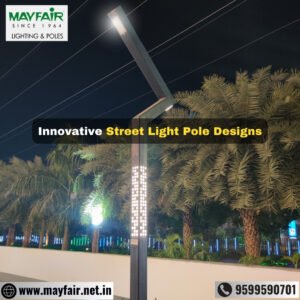
As cities around the world continue to grow, the role of infrastructure in shaping urban spaces has become more important than ever. One key aspect of modern city development is street lighting, which not only provides essential visibility for safety but also contributes to the overall aesthetic and environmental sustainability of urban environments. With advancements in technology and a shift toward sustainability, street light pole design is evolving, offering more than just illumination. It’s creating safer, more energy-efficient, and smarter urban spaces.
In this article, we will explore how innovative street light pole designs are transforming cities, focusing on the functionality, technology, sustainability, and design aspects of modern street lighting systems.
The Evolution of Street Light Pole Design
The concept of street lighting dates back centuries, with simple oil lamps used to light the streets in ancient times. As cities modernized, so did their lighting systems. For decades, street light poles were designed for basic functionality, prioritizing durability and stability. However, in today’s rapidly urbanizing world, the demand for innovative street light pole designs has increased, driven by several factors, including:
- The need for energy efficiency
- Growing concerns about environmental sustainability
- The demand for aesthetically pleasing urban spaces
- The integration of smart technologies in city planning
Modern street light pole designs go beyond just providing light. They incorporate energy-efficient technologies, sustainable materials, and smart features that allow them to adapt to the changing needs of cities. These innovations not only help reduce energy consumption but also improve safety and add to the aesthetic value of urban spaces.
Key Features of Innovative Street Light Pole Design
1. Energy Efficiency
Energy efficiency is one of the most critical components of modern street light pole design. Traditional streetlights, which use high-intensity discharge (HID) lamps, consume a significant amount of electricity. Today, most new streetlights are equipped with LED (light-emitting diode) technology, which uses up to 75% less energy than conventional lighting systems.
LED streetlights also have a longer lifespan, reducing the need for frequent replacements and maintenance. This shift to LED lighting not only lowers energy consumption but also reduces costs for cities. Furthermore, LED lights produce brighter and more focused illumination, improving visibility for pedestrians and drivers.
Many modern street light poles are also equipped with motion sensors that can detect movement and adjust the brightness accordingly. For instance, the lights can dim during periods of low activity and brighten when they detect movement, helping to conserve energy without compromising safety.
2. Renewable Energy Integration
One of the most exciting innovations in street light pole design is the integration of renewable energy sources. These street light poles are equipped with photovoltaic panels that capture sunlight during the day and store the energy in batteries, which then power the lights at night.
In addition to solar energy, some street light poles are designed to harness wind energy. Poles fitted with small wind turbines can generate electricity from wind, providing a renewable energy source that is particularly useful in areas with limited sunlight.
By integrating renewable energy sources, street light poles reduce the dependence on traditional power grids and contribute to a city’s overall sustainability goals. These designs help lower carbon footprints, making cities greener and more energy-efficient.
3. Smart Lighting Technology
Smart cities require smart solutions, and street lighting is no exception. Many modern street light pole designs now incorporate smart technology that allows cities to control and monitor their lighting systems in real time. This can be achieved through the use of IoT (Internet of Things) devices, which enable streetlights to communicate with central control systems.
Smart street light poles can be programmed to adjust brightness based on the time of day, traffic conditions, or even weather. For example, during heavy fog or rain, the lights can automatically brighten to improve visibility. These systems can also detect when a light has malfunctioned, sending alerts to maintenance teams to ensure quick repairs.
Smart street lighting not only enhances public safety but also reduces energy consumption and lowers maintenance costs, making it an ideal solution for modern urban spaces.
4. Modular and Multi-Functional Designs
The modern street light pole design is no longer just a lighting fixture; it’s a multi-functional piece of urban infrastructure. Designers are now incorporating additional features into street light poles to make them more useful in urban environments.
For instance, some poles come equipped with Wi-Fi routers, providing public internet access in busy areas. Others feature charging stations for electric vehicles, further supporting the transition to greener cities. In areas with high foot traffic, poles can include seating, greenery, or even water fountains, adding to the overall functionality and aesthetic appeal of public spaces.
Modular street light pole designs allow cities to customize their infrastructure based on specific needs, improving the efficiency of urban spaces while also enhancing the experience for residents and visitors.
5. Aesthetic and Architectural Design
While functionality is crucial, the aesthetic value of street light pole design should not be underestimated. Streetlights are a visible part of the urban landscape, and their design can contribute to the overall character and beauty of a city.
Today, many cities are incorporating unique, architecturally inspired street light poles that blend seamlessly with the surrounding environment. In historic districts, street light poles may feature traditional designs that reflect the area’s cultural heritage. In contrast, in modern business districts or tech hubs, poles may have sleek, futuristic designs that align with the area’s cutting-edge atmosphere.
Designers are also using materials like recycled steel, aluminum, and sustainable wood to create poles that are both durable and eco-friendly. These materials not only ensure the longevity of the poles but also reduce their environmental impact.
The Role of Street Light Pole Design in Urban Safety
One of the primary functions of street light poles is to enhance safety in urban areas. Poorly lit streets can lead to accidents, discourage pedestrian activity, and increase the risk of crime. By providing consistent and effective lighting, street light poles help create safer environments for both pedestrians and drivers.
Innovative street light pole designs contribute to urban safety in several ways:
- Improved visibility: LED lights produce brighter and more focused light, improving visibility for drivers and pedestrians.
- Adaptive lighting: Smart lighting systems can adjust brightness based on traffic flow, time of day, or weather conditions, ensuring optimal visibility at all times.
- Surveillance integration: Some modern street light poles are equipped with security cameras or emergency call buttons, further enhancing public safety.
By focusing on both functionality and aesthetics, modern street light pole designs help create safer, more welcoming urban spaces.
Sustainability and Environmental Impact
Sustainability is a key consideration in modern street light pole design. The integration of renewable energy sources, energy-efficient lighting, and sustainable materials helps reduce the environmental impact of street lighting systems.
Cities around the world are increasingly focused on reducing their carbon footprints, and street light poles play a critical role in achieving these goals. Solar and wind-powered street lights, along with the use of recycled or sustainably sourced materials, contribute to a cleaner, greener urban environment.
Additionally, the longevity of LED lighting and the modular design of modern street light poles reduce waste by minimizing the need for frequent replacements and repairs. This not only saves resources but also lowers the long-term costs associated with urban lighting.
The Future of Street Light Pole Design
As cities continue to evolve, so too will street light pole design. The future of urban lighting will likely see even greater integration of renewable energy, smart technology, and multi-functional designs. As part of the broader movement toward smart cities, streetlights will play an increasingly important role in creating more connected, efficient, and sustainable urban spaces.
Designers and city planners are already exploring new materials, energy sources, and features to make street light poles more eco-friendly, cost-effective, and aesthetically pleasing. In the years to come, we can expect street lights to become even more integral to the infrastructure of modern cities, contributing to safety, sustainability, and urban beauty.
Conclusion
Innovative street light pole designs are reshaping the way cities illuminate their streets, focusing on energy efficiency, sustainability, and smart technology. By incorporating renewable energy sources, adaptive lighting systems, and multi-functional features, these designs are helping cities become greener, safer, and more connected.
Also read: https://empireadda.com



